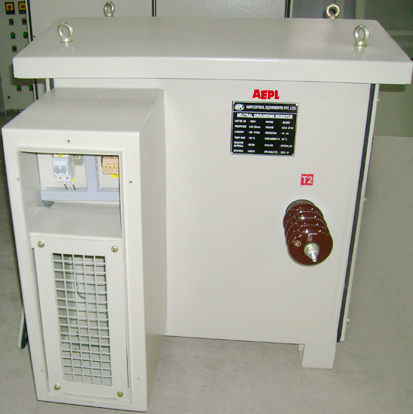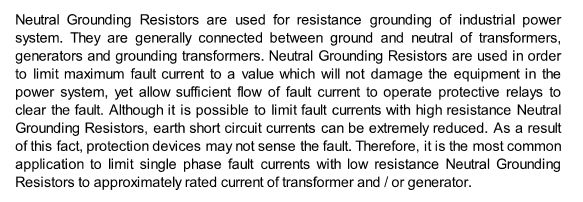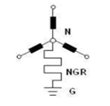Neutral Grounding Resistor:

WHAT IS A NEUTRAL GROUNDING RESISTOR: -
The Neutral-Grounding Resistor is the connection between the system neutral and ground. It provides a path for ground-fault current to return to the transformer neutral.

WHY WE USE NGR : -
- To reduce burning and melting effects in faulted electrical equipment, such as switchgear, transformers, cables, and rotating machines.
- To reduce mechanical stresses in circuits and apparatus carrying fault currents.
- To reduce electrical-shock hazards to personnel caused by stray ground fault
currents in the ground return path.
- To reduce the arc blast or flash hazard to personnel who may haveaccidentally caused or who happen to be in close proximity to the ground fault.
- To reduce the momentary line-voltage dip occasioned by the occurrence and clearing of a ground fault.
- To secure control of the transient over-voltages while at the same timeavoiding the shutdown of a facility circuit on the occurrence of the first groundfault (high-resistance grounding).”
BASIC CONSTRUCTION :

WHAT IS LOAD BANK:-
Load banks are compact units that are coupled to the output of your power generation system such as diesel generators, gas turbines or UPS and battery systems.
Load banks are dummy loads, designed to simulate the plant load and prove the design, performance and the capacity of the system, without interruption to the normal running of your plant.
Load Banks - dummy loads - are used to replace building loads when testing emergency backup power generators. They are an electrical artificial load that is why sometimes they are referred to as dummy loads.
WHAT DOES A LOAD BANK DO :-
Generators are usually rated to supply sufficient power to a plant or building, based on the maximum demand required. Sufficient plant loading is not always available to safely load generators.
Under loading of the engine will cause a high wear rate due to insufficient fuel combustion and loss of lubrication resulting in cylinder bore glazing and fouling of exhaust ports and valves. Running the generator without load will not prove its performance or power capacity.
Proper and controlled loading is therefore essential. It increases diesel engine life by up to
four times and improves the efficiency by ensuring that the engine has sufficient loading at all times.
It proves the rated power, proves system operation, controls integrity and communications of your power system. It maximize battery life in UPS systems by regular loading and discharging.
WHAT IS DYNAMIC BRAKING RESISTOR: -
When an induction motor’s rotor is turning slower than the synchronous speed
set by the drive’s output power, the motor is transforming electrical energy
obtained from the drive into mechanical energy available at the drive shaft of the
motor. This process is referred to as motoring. When the rotor is turning faster
than the synchronous speed set by the drive’s output power, the motor is
transforming mechanical energy available at the drive shaft of the motor into
electrical energy that can be transferred back to the drive. This process is referred
to as regeneration.
Most AC PWM drives convert AC power from the fixed frequency utility grid
into DC power by means of a diode rectifier bridge or controlled SCR bridge
before it is inverted into variable frequency AC power. Diode and SCR bridges
are cost effective, but can only handle power in the motoring direction.
Therefore, if the motor is regenerating, the bridge cannot conduct the necessary
negative DC current, the DC bus voltage will increase and cause an overvoltage
fault at the drive. More complex bridge configurations use SCRs or transistors
that can transform DC regenerative electrical power into fixed frequency utility
electrical energy. This process is known as line regeneration.
A more cost effective solution can be provided by allowing the drive to feed the
regenerated electrical power to a resistor which transforms it into thermal energy.
This process is referred to as dynamic braking.
Advantages of using Dynamic Braking Resistors:
- Faster braking of DC and AC motors.
- Lower wear and tear of friction braking components.
- Keep motor voltages within safe levels.
- Eliminate risk of a runaway due to overheated friction brakes in some motors.
- Reduce wasted time during braking.
- Increase life of the equipment.
- Improved service reliability.
Harmonic Filter Resistors:-
The purpose of a harmonic filter is to reduce distortions in power systems, produced by non-linear loads such as arc welders, induction furnaces, VFDs, ballasts, computer equipment, and phones, UPSs etc., which can cause failure of motors, transformers and switchgear through insulation breakdown, arcing and overheating.
In a normal AC power system, supply voltage varies sinusoidally with a fundamental frequency of 50 or 60 hertz. When linear loads, such as resistive heaters, incandescent lamps, constant speed induction and synchronous motors, are connected to the system, sinusoidal currents will be drawn from the system at the same frequency as the voltage. However when non-linear loads are connected, a series of sinusoidal currents, called harmonics, will be drawn at integer multiples of the fundamental frequency.
Advantages of using Harmonic Filters:-
- Reduced neutral currents and resonance
- Improved voltage stability
- Reduced system losses
- Increased equipment life
- Reduced phone system interference
- Improved system reliability